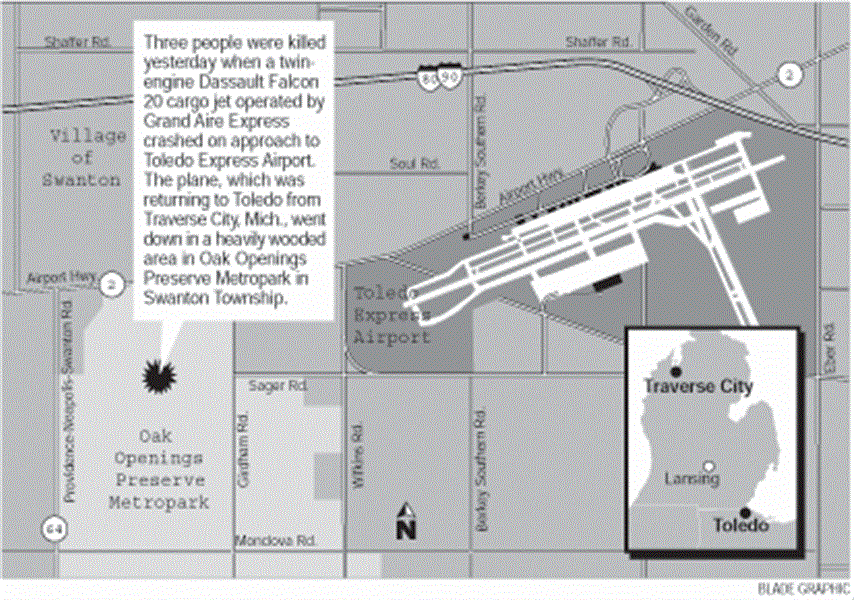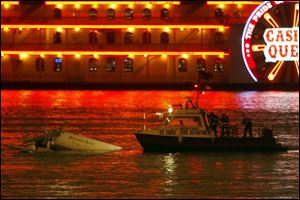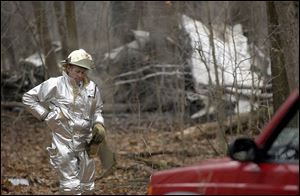
Jet crashes kill 3 in Oak Openings, hurt 2 in St. Louis; Toledo-owned Grand Aire loses 2 planes on same day
4/9/2003
Two cargo jets flown by Toledo-based Grand Aire, Inc., crashed yesterday in separate accidents, one near Toledo Express Airport that killed three and one in St. Louis that seriously injured two.
Hours after a Grand Aire jet crashed in Oak Openings Preserve Metropark on approach to Toledo Express, another company jet went down in the Mississippi River just north of downtown St. Louis. The latter crew was rescued after 15 minutes in the water.
The FAA and the National Transportation Safety Board are investigating the crashes.
The first occurred about 2 p.m. in western Lucas County when a twin-engine Dassault Falcon 20 cut a 200-yard swath through dense woods in Oak Openings in Swanton Township about two miles southwest of the airport, where it was trying to land.
The victims were identified as David Davenport, 40, of Ottawa County's Harris Township near Elmore; Steven William “Will” Forshay, 37, of Springfield Township; and Wallis Bouldin, 32, of Louisville. All were certified pilots working for Grand Aire, although officials said they did not know who was flying the plane at the time of the crash. One of the men was hitching a ride on the plane from its stop in Traverse City, Mich.

A fire boat keeps watch on wreckage of a Grand Aire plane floating down the Mississippi River. Both pilots were rescued.
About 7:30 p.m. Eastern Daylight Time, another Grand Aire Falcon 20 - the company had 13 of the Falcon jets - crashed in the Mississippi. Local media reports indicated that one of the crew was in critical condition and the other was in serious condition. Weather conditions were similar to the Toledo crash: fog, mist, and surface temperatures in the mid-30s.
Except for the Sept. 11, 2001, terrorist hijackings, the FAA cannot remember a single carrier having two crashes in the same day.
“It's very unusual - very unusual,” said FAA spokesman Elizabeth Isham Cory.
In the Swanton Township crash, the Grand Aire jet clipped a stand of trees about two miles from Toledo Express Airport, officials said. The wreckage was in the metropark, south of Airport Highway and west of Girdham Road at Sager Road.

The jet, built in 1968, was approaching the airport from the west when it went down just before 2 p.m. Air traffic controllers immediately contacted emergency crews after they lost radar contact with the plane.
Tahir Cheema, president and CEO of Grand Aire, spoke briefly at the company's headquarters at Toledo Express after he had personally contacted the families of the victims.
“Three very experienced pilots ... were lost,” he said. “Right now our prayers are with their families. This is a very unfortunate incident.”
Contacted in his office after news of the St. Louis crash, Mr. Cheema declined comment.
“I can't talk right now,” he said.
The company flies between 10 and 15 flights a day out of Toledo Express.
“This is a tragedy,” said James Hartung, president of the Toledo-Lucas County Port Authority, which operates the airport.

Master Sgt. Mike George, fire chief of the 180th Air National Guard, works at the crash site in Oak Openings Preserve Metropark.
In St. Louis, the company's Falcon 20 was bound from Del Rio, Texas, to St. Louis Lambert International Airport. The plane missed its initial approach at the airport and was conducting a go-around when “it may have lost an engine and went to the Mississippi,” Ms. Cory said.
According to information given to the NTSB, the pilot reported being low on fuel. He then reported the sequential failures of his plane's two engines before going into the river.
It crashed near the McKinley Bridge and broke apart in the water. St. Louis police and fire officials said the pilot and co-pilot, after floating downriver, were rescued from the water - one of the victims was sitting on the floating plane - near the Martin Luther King, Jr., Bridge on the St. Louis waterfront.
They were taken to St. Louis area hospitals. Their identities were not released last night.
Officials said no passengers were aboard the plane. The Coast Guard closed the river to barges and other traffic.
Hours earlier near Toledo Express, nearby residents said they thought they heard a plane with engine trouble.
Patricia and James Miller live on Route 64 and are accustomed to the sound of landing planes. This one was far different, they said.
“It was two separate bangs,” Patricia said. Then came the impact. “It was one helluva noise,” Mr. Miller said.
Ron Height, a siding contractor, was driving west on Airport near Girdham when he saw the smoke. He immediately headed for the scene.
After walking through thick woods for about a mile, he and two Ohio Highway Patrol troopers were the first to find the burning wreckage.
“It was just solid smoke,” Mr. Height said. “There just wasn't anything we could do.”
Officials from the National Transportation Safety Board were expected to arrive at Toledo Express today. A three-member crew from the Federal Aviation Administration arrived last night to begin an investigation, which is expected to last several days.
At the time of the accident, it was cloudy and foggy with freezing rain and drizzle, according to the National Weather Service. Weather is one of the factors investigators always consider. Among the factors also checked: recent maintenance on the plane and the pilots' certification and histories.
Maintenance records sent to the FAA show no major problems were reported for the aircraft involved in the Toledo crash between June, 1997, and July, 2002.
The Falcon 20 was a popular European business jet about 20 years ago, said Dick Williams, president of Aviation Data Source, Inc., in Denver “They're not hard to fly. They're very powerful,” he said.
According to the Grand Aire Web site, the company's Falcon 20s represent half of its 26-plane fleet. The plane is owned by Czars, Inc., of Wilmington, Del.
The Toledo-area crash is the second fatal accident for the company in less than a year. Mukesh Gupta, 25, died July 18 near the Columbus, Ind., airport after the Piper Aerostar PA-600 he was piloting crashed along the runway.
Grand Aire provides air cargo services throughout the country and Mexico and Canada. A good portion of its business involves the shipment of auto parts.
In Swanton Township, witnesses reported hearing engine trouble as the plane went overhead. Because of the low clouds - visibility was limited to one mile - they did not see the plane. They did, however, hear it.
“It sounded fine,” said Roger Heineke, who lives about 1/4 mile north of the crash scene. “But when it got even with us, the engine started to backfire. Then everything was fine for about three seconds, then it backfired again, then it was fine and then `Bam!' The third one was huge. I don't know, it might have been the crash.”
Leo Hall, plant operator at the Swanton Water Treatment Plant on State Rt. 64, was outside when the plane went over.
“We just heard an engine cut out. Then it came back on. You could hear it cut out and then it re-fired.”
After he scrambled onto the roof of the plant, he could see smoke coming from the metropark.
The thick woods made it difficult for fire crews to get there. But authorities said the damp weather eliminated the chance of a forest fire, said Master Sgt. Mike George, fire chief at the Air National Guard base.
Although the flames were quickly put out, the plane was still smoldering four hours later.
Responding were fire and police crews from Swanton, Swanton Township, Springfield Township, Monclova Township, the Ohio Air National Guard, the Toledo Express fire department, the Ohio Highway Patrol, and the Lucas County Sheriff's Office.
The bodies were recovered about 7:20 p.m. and taken to the Lucas County coroner's office. Two of the victims were badly burned and final identification will require dental records, said Dr. Diane Barnett, a deputy coroner. An autopsy is scheduled for today.
The local Salvation Army and the American Red Cross chapters provided aid to the dozens of emergency personnel who worked the accident scene.
Staff writers Clyde Hughes, Rod Lockwood, Joe Mahr, David Patch, Mike Sigov, George Tanber, and Mark Zaborney contributed to this report.